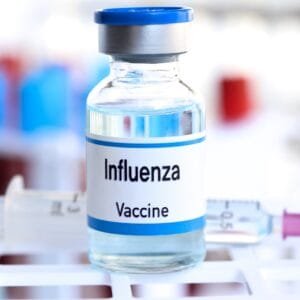Influenza: Causes, Symptoms, and Treatment
Influenza, commonly known as the flu, is a highly contagious viral infection that primarily affects the respiratory system, including the nose, throat, and lungs. Caused by influenza viruses, the flu is characterized by sudden onset symptoms such as fever, chills, body aches, and fatigue. While most cases resolve without complications, influenza can be life-threatening, especially for high-risk groups such as the elderly, young children, and individuals with weakened immune systems.
What is Influenza?
Influenza is a seasonal illness caused by influenza viruses belonging to the Orthomyxoviridae family. The flu typically occurs in annual outbreaks, with higher prevalence during the fall and winter months in temperate climates.
The two primary types of influenza viruses that infect humans are:
- Influenza A: Responsible for most flu epidemics and pandemics.
- Influenza B: Causes seasonal flu but is generally less severe than type A.
Both influenza A and B viruses evolve rapidly, leading to new strains each year, which necessitates annual vaccination.
Causes of Influenza
Influenza spreads through respiratory droplets when an infected person talks, coughs, or sneezes. It can also spread by touching contaminated surfaces and then touching the mouth, nose, or eyes.
Risk Factors for Influenza
- Close Contact:
- Being in crowded places, such as schools or workplaces, increases exposure.
- Weakened Immune System:
- Chronic conditions or medications that suppress immunity.
- Age:
- Infants, young children, and adults over 65 are at higher risk.
- Pregnancy:
- Pregnant women are more susceptible to severe flu complications.
- Seasonal Variability:
- Flu activity peaks during the winter months.
Symptoms of Influenza
Flu symptoms appear suddenly, usually 1–4 days after exposure to the virus. Common symptoms include:
Mild to Moderate Symptoms
- Fever and Chills:
- Fever is often high, accompanied by shivering.
- Cough:
- Dry and persistent.
- Body Aches and Fatigue:
- Severe muscle aches and overwhelming tiredness.
- Sore Throat:
- Inflammation in the throat, often with redness.
- Headache:
- Common with other flu symptoms.
Severe Symptoms
- Shortness of Breath:
- May indicate complications like pneumonia.
- Chest Pain:
- A sign of more serious illness.
- Dizziness:
- Severe weakness or light-headedness.
- Vomiting and Diarrhea:
- More common in children than adults.
Diagnosis of Influenza
A flu diagnosis is based on clinical evaluation and, if necessary, laboratory testing:
- Physical Examination:
- Symptoms like fever, cough, and body aches are assessed.
- Rapid Influenza Diagnostic Tests (RIDTs):
- Detect antigens from influenza viruses in respiratory samples within 15–30 minutes.
- PCR Testing:
- A more sensitive method that identifies viral RNA for specific strains.
- Chest X-Rays:
- Used to rule out complications like pneumonia.
Treatment Options for Influenza
While most flu cases resolve with rest and self-care, severe cases or high-risk individuals may require antiviral medications.
Medications for Influenza
- Antiviral Drugs:
- Oseltamivir (Tamiflu), Zanamivir (Relenza), and Baloxavir (Xofluza) can reduce the severity and duration of the illness when taken within 48 hours of symptom onset.
- Fever Reducers and Pain Relievers:
- Acetaminophen or ibuprofen for fever, headaches, and body aches.
- Decongestants and Cough Suppressants:
- Relieve nasal congestion and coughing.
Home Remedies and Self-Care
- Hydration:
- Drink plenty of fluids to prevent dehydration.
- Rest:
- Get adequate sleep to help the immune system fight the virus.
- Humidifier Use:
- Moistens the air, easing breathing and reducing nasal irritation.
- Warm Saltwater Gargle:
- Helps soothe a sore throat.
Preventing Influenza
Prevention focuses on vaccination, personal hygiene, and avoiding exposure to the virus.
1. Annual Flu Vaccination
- The flu vaccine is the most effective way to prevent infection and its complications. Vaccines are updated yearly to target circulating strains.
2. Good Hygiene Practices
- Wash hands regularly with soap and water for at least 20 seconds.
- Use alcohol-based hand sanitizers when soap is unavailable.
- Avoid touching your face, especially the eyes, nose, and mouth.
3. Avoid Crowded Places
- Limit exposure during flu outbreaks by avoiding large gatherings or crowded areas.
4. Cover Your Cough
- Use tissues or the crook of your elbow to cover your mouth when coughing or sneezing.
Complications of Influenza
Flu complications can range from mild to severe and are more common in high-risk populations:
- Pneumonia:
- A bacterial or viral lung infection that often follows the flu.
- Sinus and Ear Infections:
- Secondary infections caused by inflammation in the respiratory tract.
- Worsening of Chronic Conditions:
- Flu can exacerbate asthma, heart disease, or diabetes.
- Sepsis:
- A life-threatening immune response to severe infections.
- Death:
- Severe cases, especially in the elderly or immunocompromised individuals, may be fatal.
FAQs about Influenza
1. What causes influenza?
Influenza is caused by influenza viruses, primarily types A and B, which infect the respiratory system.
2. How is the flu different from a common cold?
While both are respiratory illnesses, the flu causes more severe symptoms like high fever, body aches, and fatigue, whereas a cold typically results in milder symptoms.
3. How long does the flu last?
Most people recover within 7–10 days, although fatigue and cough may persist longer.
4. Can influenza be prevented?
Yes, through annual vaccination, good hygiene practices, and avoiding contact with sick individuals.
5. Who should get the flu vaccine?
Everyone aged 6 months and older should receive the flu vaccine, especially high-risk groups like the elderly, pregnant women, and those with chronic conditions.
Conclusion
Influenza is a highly contagious respiratory illness that can have significant health impacts, particularly for vulnerable populations. Annual vaccination, good hygiene practices, and prompt medical care can reduce the risk of infection and complications. If you experience flu symptoms, consult a healthcare provider for proper diagnosis and management. Staying proactive during flu season is essential for protecting yourself and those around you.



